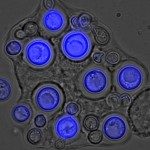Link to Pubmed [PMID] – 21851418
APMIS 2011 Sep;119(9):605-10
Eurotium amstelodami, a mold frequently identified in housing and farm air samples, is a suspected cause of respiratory diseases such as allergic alveolitis, atopic asthma, and organic dust toxic syndrome. This fungus is present in the air in three different states (ascospores, conidia, and hyphae). The aim of this study was to test in vitro the differential inflammatory response of airway cells exposed to 1,3 betaglucanase-treated protein extract (BGPE), from E. amstelodami ascospores, conidia, and hyphae. Confluent cells from the A549 cell line were inoculated with calibrated BGPE issued from the three fungal forms. The levels of eight cytokines and chemokines involved in inflammatory responses were measured after 8 h of exposure. Beta-d-glucan (BDG) was quantified in total fungal extract as well as in the BGPE from the three fungal states. Hyphal BGPE were the only ones to induce a marked inflammatory response and they contain higher quantities of BDG. The present study adds to the growing body of evidence that beta-glucan from fungal hyphae play a crucial role in respiratory diseases.

